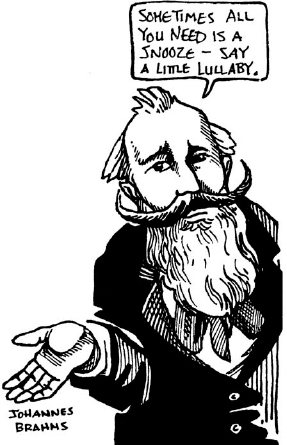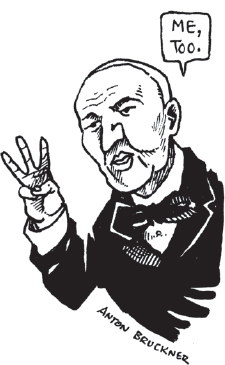

Music composed after the middle of the nineteenth century might seem to be more diverse than that of earlier eras due to the more careful preservation of historical data; however, that diversity was indeed the case, and only the twentieth century would eclipse the late 1800s in diversity of musical styles, forms, and genres. Before the nineteenth century, the music performed was by living composers, or at most a composer who had died within a few decades; rarely did the performance of a composer's music survive beyond a generation. By the middle of the nineteenth century, choral, chamber, and orchestra concerts consisted increasingly of the established classical repertoire.
The older music of the First Viennese School was here to stay, and this posed a major conundrum for composers in the mid-1800s: what path should they follow? Should they continue composing in the established idioms of Mozart, Haydn, and Beethoven, while adding their own innovations and flare to the recognizable precedents as Johannes Brahms did? Or should they guide their music in a different direction, creating new genres and styles as Wagner and Liszt did? The late nineteenth century was filled with polarizing dichotomies such as absolute versus program music, convention versus novelty, and classical forms and genres versus new ones. Regardless of the direction, it is evident that both sides of the dispute sought to link their works with the legacy of Beethoven.

When Johannes Brahms (1833-1897) was a mere twenty years old, sixty percent of all concert music was that of dead composers; by age forty that number was closer to eighty percent. Brahms elected to follow the path of the masters and sought to compose works that would rival their compositions while providing something fresh and innovative. He not only admired the work of composers like Bach and Beethoven, but also found inspiration in their music for his own creations. Brahms spent nearly twenty years composing his first symphony, knowing well he was standing in the shadow of the great Beethoven. Brahms once stated, “You have no idea how someone like me feels when he hears such a giant marching behind him all the time.” Indeed, Beethoven was a giant, but so was Brahms. In fact, he is commonly considered to be Beethoven's successor. His first symphony in C minor was in many ways modeled after Beethoven, but produced music that was distinctly Romantic. The final movement, which concludes in C major like Beethoven's Fifth Symphony, is a clear homage to Beethoven—Brahms interpolates and reworks the “Ode to Joy” melody of Beethoven's Ninth Symphony.
Brahms was Beethoven's true successor not only in orchestral music, but also in chamber music. His output of twenty-four chamber works is not nearly as impressive as the painstaking quality that each exhibits. In his chamber works and symphonies alike, one can distinctly hear the influence of earlier models in a language that is clearly identifiable as Brahms'. Brahms wrote a number of extraordinary works in the genres of piano music (developing his own imaginative style), song (using the Lieder of Schubert as a model), and choral music (inspired by the music of Heinrich Schütz and Bach). One of the greatest all-time compositions is Brahms' Ein Deutsches Requiem (A German Requiem), composed for soprano and baritone soloists, chorus, and orchestra. The influence of Bach and Schütz is evident in Brahms' imitative treatment of vocal parts and in the text expressivity. While inspired by older models, the work is groundbreaking in the text chosen: instead of using the Latin Mass for the Dead, Brahms compiled texts drawn from the Old Testament, Apocrypha, and New Testament. It is well known that Brahms composed this not as a mass for the dead, but as a comfort for the living.

While it may seem that Brahms' music was conservative at the time, he actually was a trailblazer, setting traditional inherited forms in his own idiom and language. At the same time, another branch of composers who sought to break from the past was emerging. Music critic Franz Brendel grouped leading music innovators Liszt, Wagner, and Berlioz together in what he called the “New German School.” This might not make much sense, given that neither Berlioz nor Liszt were German, but Brendel was referring to the fact that all sought to follow in the footsteps of Beethoven, which makes their music German in origin. These and other composers were considered Wagnerian in that they followed Wagner's new path away from the classical repertoire.

Surprisingly, one of the earliest Wagnerian's was Franz Liszt, who, after retiring from his career as a touring pianist, focused his efforts on composition while working as the court music director at Weimar. Because he was no longer composing works simply to demonstrate his virtuosic talent, Liszt was able to free himself of the established tradition. He created a new genre of orchestral music that he called the symphonic poem, a one-movement programmatic work that was suggested by a picture, play, poem, or other art form. Analogous to the literary poem, Liszt's new genre fell in line with Wagner's philosophy of a collective artwork.

Viennese composer Anton Bruckner (1824-1896) not only shared Wagner's outlook on music, but also sought to fully absorb Wagner's style and musical language in his own orchestral compositions. Like other Wagnerian composers, Bruckner modeled his symphonies on the music of Beethoven, particular the Ninth Symphony, in an effort to achieve the same level of purpose, grandeur, and religious spirit. Bruckner's symphonies also followed Beethoven's lead in the recycling of previously presented musical materials in the final movement. The music of Hugo Wolf (1860-1903), on the other hand, exemplifies the adaption of Wagner's approach to German lied. While Wolf composed music in a number of genres, his greatest success laid in his songs. Producing some two hundred fifty lieder in a period of ten years, Wolf concentrated his efforts on one poet at a time, and he also embraced Wagner's new ideal of equality between words and music. He prescribed to Wagner's philosophy of a collective artwork, successfully fused music and poetry, and achieved a balance between piano and voice that required neither to be subordinate to the other.

While each of the composers in this chapter followed a different path, all were successful in the path they chose to follow. Brahms composed music in a wide variety of traditional forms and genres, paying homage to Bach, Handel, and the First Viennese School. Other composers who prescribed to Wagnerian wing of music, focused more narrowly on specific genres while following Wagner's lead in the collective artwork, form, and harmony.